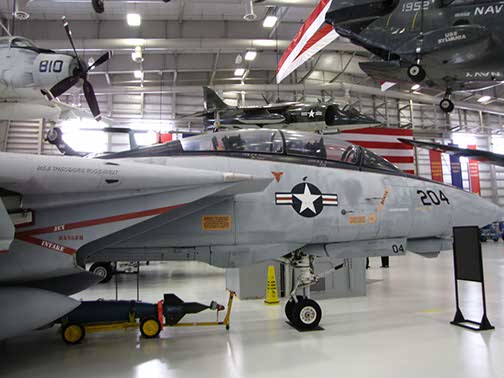NAS Pensacola
Nine photos from the Naval Air Station museum in Pensacola, Florida.
F-14D Tomcat side
In September 1986 an F-14A Plus "Super Tomcat" completed its maiden flight making Mach 1.1 at 25,000'. Navy accepted the first production F-14A Plus in November 1987, as precursor to the F-14D. However appearance in a squadron did not occur until April 1988, at VMF-101. Fitted with LANTRN in the 1990s, the Tomcat served in a strike capacity as well, until replaced after 2006 as both fighter and strike aircraft by the F-18A/B and the Super Hornet F/A-18D/E.
Object Notes F-14A Tomcat painted in the markings of Fighter Squadron (VF) 101, the famous "Grim Reapers," which served as the Fleet Replacement Squadron at Naval Air Station (NAS) Oceana, Virginia.
It was a failed attempt at standardization that resulted in the design of perhaps the most famous fighter of the modern era, one that flashed across the silver screen and roared into skies around the world. When a navalized version of the U.S. Air Force F-111 failed to meet exacting requirements of a Navy carrier-based fighter, resulting in the cancellation of the program in 1968, the sea service initiated a design competition for a new air superiority fighter. The result was a design marvel featuring a unique variable sweep wing that automatically shifted in flight from 28 to 60 degrees sweep for optimum performance at any speed. In addition, it was equipped with a weapon control system that enabled the aircraft's crew to track twenty-four hostile targets at a range of 195 miles and attack six simultaneously with Phoenix missiles.
Deliveries to the Navy began in June 1972 with deployment of operational carrier squadrons in 1975. The F-14 made a brief appearance over Vietnam, flying protective patrols for helicopters effecting the final evacuation of American personnel and foreign nationals from Saigon with no opposition from enemy fighters. The Middle East was destined to become the scene of the Tomcat's combat initiation during encounters with Libyan fighters over the Gulf of during the 1980s. It was also during that decade that F-14s intercepted an aircraft carrying the hijackers of the Italian cruise ship Achille Lauro, forcing the aircraft to make a landing so that they could be apprehended. Tomcats also flew combat missions during the Gulf War and in missions over Iraq and Afghanistan from 2001 until its retirement in 2006, the aircraft proved an outstanding air-to-ground platform employing a capability present from the initial design work, but rarely employed. At peak employment, thirty Navy squadrons operated F-14s, in latter years the complements including F-14A (Plus) and F-14Ds, featuring improved avionics and power plants.
Place of Origin Bethpage, New York
Notes Specifications
Manufacturer: Grumman Corporation
Dimensions: Length: 62 ft., 8 in.; Height: 16 ft.; Wingspan (fully extended): 64 ft., 1 �
in.
Weight: Empty: 40,104 lb.; Gross: 74,349 lb.
Power Plant: Two 20,900 lb. Pratt and Whitney TF30-P-412A/414A turbofans
Performance: Maximum Speed: 1,544 M.P.H. at 40,000 ft.; Service Ceiling: 55,000 ft.
Range: 2,400 miles
Armament: One 20mm cannon, AIM-7 Sparrow, AIM-9 Sidewinder, and AIM-54
Phoenix missiles
Crew: Pilot and Radar Intercept Officer
